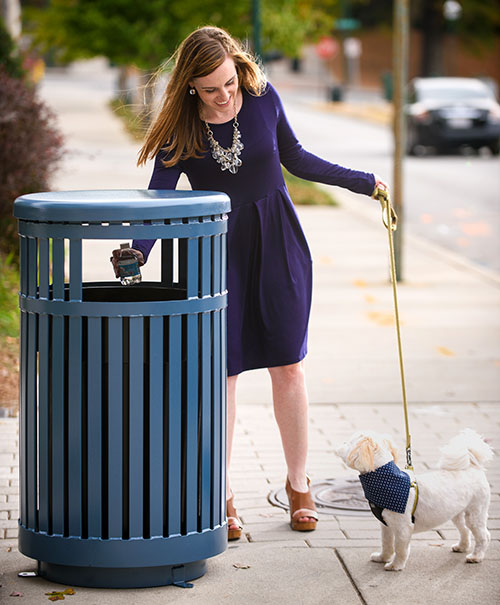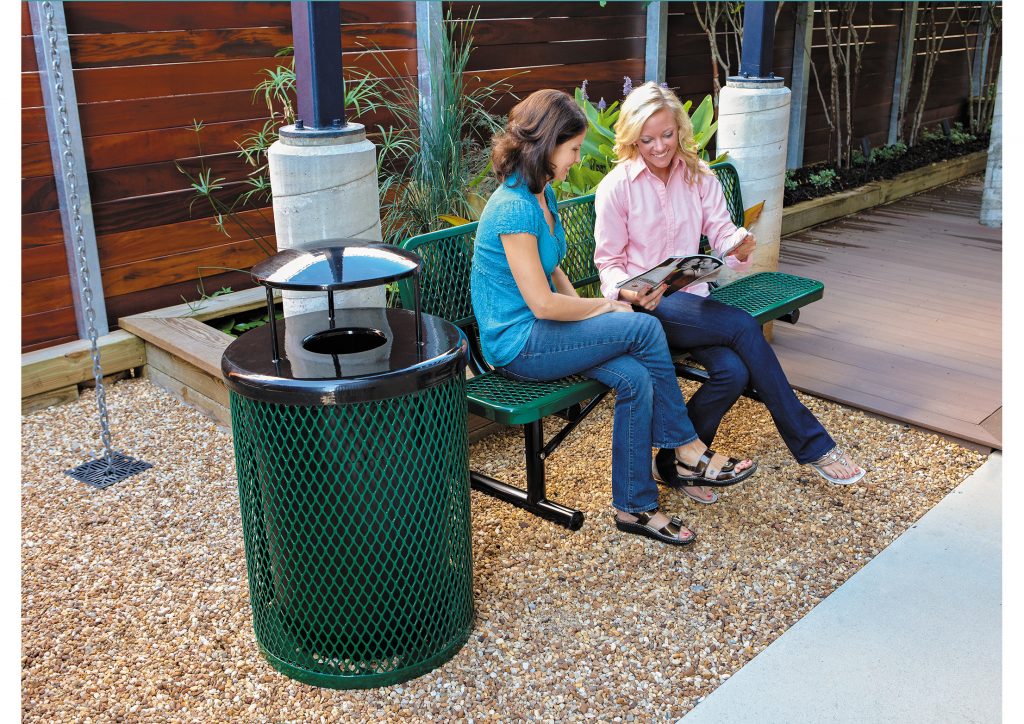 Commercial garbage cans for businesses are now available in a variety of attractive styles and colors to help contain litter in local communities
Commercial garbage cans for businesses are now available in a variety of attractive styles and colors to help contain litter in local communities
These statistics reveal how businesses bear the brunt of the fight against litter and why commercial garbage cans play a key role in not only keeping the area around a business clean, but also helping the overall appearance of the community.
According to Keep America Beautiful, businesses pay a staggering $9.1 billion per year in removing trash and the fight against litter. That ranges from the installation of trash receptacles to garbage hauling to the efforts of company employees.
Litter overall cost the US more than $11.5 billion annually.
So, you can see how businesses bear the financial burden of keeping our cities clean.
And there is a direct benefit to a community.
When they are plenty of commercial garbage cans in place at businesses, on city streets and in parks to keep the streets clean, there are important economic benefits.
Trash affects not just businesses, but communities as well
According to a 2009 study on the impact of litter:
- More than 50% of Realtors believe litter hurts and reduces home and property values by nearly 10%.
- Property appraisers do take the presence of trash into account when evaluating a property. In another survey, 60% of appraisers said trash would cause them to reduce the value of a property.
- When homeowners were asked the same question, the responses were even more dramatic. About 93% of homeowners said in their mind litter decreases home values. They acknowledged that the presence of trash would be a major influence on their decision to buy a property.
- Nearly half of consumers said in their opinion, litter can cut a home's value by 10% to 24%.
- The National Association of Home Builders keeps an eye on the litter situation as well. In their own research, they found that litter hurts property values by as much as 7%.
- Trying to attract businesses to your community to expand the tax base and provide jobs? Litter affects that effort as well. According to the KAB, a survey of business development professionals, the people who work to establish or relocate businesses to an area, 36% of respondents said litter does negatively affect a CEO's decision to relocate to a community.
One important factor to consider about litter is the type of litter you find in your environment.
Here are the most common sources of litter at pedestrian transition points (as opposed to roadways) according to Keep America Beautiful.
No. 2 might surprise you.
- Confection - 53.7% - candy, chocolate and gum wrappers
- Tobacco - 29.8%
- Paper - 6.1%
- Glass - 3.8%
- Metal - 2.1%
- Plastic - 2%
- Organic - 1.6%
- Other - .9%
Discarded tobacco products are also responsible for 34% of all roadway litter.
That is why it's also important that facility managers not only be sure to add a large number of commercial garbage cans, but also an adequate number of cigarette receptacles and smokers' ashtrays.
Most smokers have said they will use outside ashtrays in they are made available.
While small in size, discarded cigarette litter can add up. And it's certainly unsightly and a hazard to small children and animals.
Fast food packaging is also a major source of litter. In a study following a beach clean-up, 5.3% of the litter found was attributed to trash from take-out food.
How businesses can be pro-active and set an example with employees
For businesses that produce a large amount of trash, take-out restaurants for example, its critical that they have an adequate number of commercial garbage cans on their premises.
Makes sense. When people were observed in public places, they were likely to litter if the commercial trash cans were about 29 feet away on average. If people were closer, say within 10 feet of a trash receptacle, the litter rate dropped 88%. That's phenomenal.
(By the way, want to know why Disney theme parks are always spotless? Walt Disney used to observe customers and determined that the nearest commercial garbage can needs to be within 25-30 steps or people will drop their trash on the ground).
And, it's important employees empty those trash receptacles as needed.
One of the most important factors that KAB has found in its research is that litter creates more litter. When people have a food container or wrapper to discard, if they see that people are throwing their trash on the ground in front of an overfilled commercial garbage can, they will do the same.
It's peer influence at its worst.
The solution - plenty of commercial garbage cans
Here's another interesting fact to consider. The population is growing.
In the US, there are about 3.5 million new residents populating the country every year.
Experts also predict, more and more of those residents will flock to urban (and surrounding suburban areas) in the future in the search for jobs and lifestyle amenities that only a city can offer, and young people prefer.
That's another reason to be sure there are plenty of commercial garbage cans available. Place them at key transition points and high traffic areas such as entrances, exits, near picnic tables or benches, parking lots, etc.
Also, be sure to add plenty of signage reminding people to dispose of their trash in the commercial trash cans provided.
____
Tim Horton restaurants post this note by their doors - "Be a Good Neighbor, Don't Litter."
_____
Educate your employees about the negative consequences of litter.
Be sure to the schedule emptying of trash cans to meet volume needs.
Ask them to go the extra mile in making sure the establishment and surrounding areas are well kept.
For example, employees at White Castle restaurants in New York and New Jersey are instructed to clean the restaurant property and the block around it to be sure the area is clean.
The Tim Horton restaurant chain in Ontario regularly participates in more than 300 community cleanups each year. The 2,000 stores are involved in regular anti-litter programs.
If necessary, create an observation checklist to determine the types of trash being thrown out, where litter occurs most and peak times to empty trash receptacles.
In addition, make sure sanitation crews don't leave a mess when removing the trash.
Here's a link to convenient checklists for businesses to use to optimize trash collection and litter prevention.
Commercial garbage cans don't have to be unsightly
The good news is, trash receptacles today don't necessarily need to be ugly in appearance.
 Metal commercial garbage cans that are available in a wide variety of colors and durable coatings
Metal commercial garbage cans that are available in a wide variety of colors and durable coatings
There are plenty of commercial garbage cans on the market that don't look like those old-fashioned, shiny (and sometimes dented) aluminum garbage cans.
Now commercial garbage cans can be ordered in an array of contemporary styles and a huge variety of appealing colors.
Some of the materials used to manufacture commercial garbage cans include:
- Metal - with a powder coated or super-durable thermoplastic coating, available in a large variety of colors and with the ability to add logos
- Concrete - with a variety of attractive finishes such as Weatherstone, Dura-Brite or Sand Blasted, etc.
- Recycled Plastic - what's a better way to make a statement about the environment than by adding trash receptacles made from recycled plastic scrap. This completes the recycling loop of Collection, Manufacturing and Reuse.
- Fiberglass - lightweight with an incredible choice of vibrant colors ranging from Violet to Candy Apple with a gloss or textured finish.
- Aluminum - lightweight, easy to maintain, rustproof with a brilliant satin finish
- Wood - attractive trash receptacles that blend into a wooded environment with either treated pine or oak slats.
Bottom line: preventing litter is a big challenge, cost and responsibility for businesses today. Not only does it affect their establishment, but it also contributes to the overall aesthetics and health of the community as a whole. A savvy business will work extra hard to show the community (and their customers) they care about preventing litter.
Be sure your business is doing its best with the installation of the right number of commercial garbage cans with adequate capacity, the addition of recycling receptacles and providing plenty of outdoor ashtrays.


